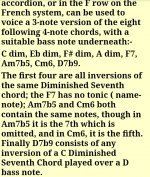Thanks, that's interesting. I see the third and fourth versions are essentially the first and second, reversed from top to bottom, with some indication that this might be a Belgian thing (in which case I guess the layout might more likely be square, and I suppose that would clearly call for C - E - Eb.)
I think the chart is wrong, about the dominant 7th row. There's only one way it can work, and that means the dominant 7th isn't 1-3-7 as they write, but rather 3-5-7 (for C7, E-G-Bb); the diminished is then 1-3-7 of the adjacent row (for Cdim on the G column, G-Bb-E.) Maybe that's what they mean and I'm just being obtuse. Anyway, it's the most significant difference in a way, since every time you play dominant 7 chord you get different notes out of it, and I occasionally wonder if that makes any real difference in the sound.
In Roland digital accordions, at least in my FR-4x, there are several ways to configure bass layouts, as has been described in previous methods. But sticking with a 2+4 layout gives some interesting results as far as midi transmission is concerned. There are three modes; normal, D-mode and accordion.
The default is normal (don’t ask me why.) In this mode, major and minor chords are transmitted as the usual triads, but sevenths are transmitted as full dominant sevenths (the fifths are included,) and diminished chords as diminished sevenths (1-b3-b5-6.)
Using the menu, you can select d-mode. In which only the root note of the chord is transmitted, but in four different octaves, depending on whether the chord button you press is major, minor, seventh or diminished.
Again, usung the menu, you can choose accordion- mode. This is an all-triad transmitting mode. I have not explored it as to wherher the chord buttons send midi messages for the chords in root position or in some inversion.
Two things must be remembered, however. The first is that the above mode descriptions refer only to what the accordion transmits in midi messages, NOT what you would hear from the accordion’s speakers or an external amp, if connected.
The second thing to remember is that selecting d-mode or accordion-mode will not be “remembered”
by the accordion unless you perform the additional step of saving that setting before turning off the accordion.

